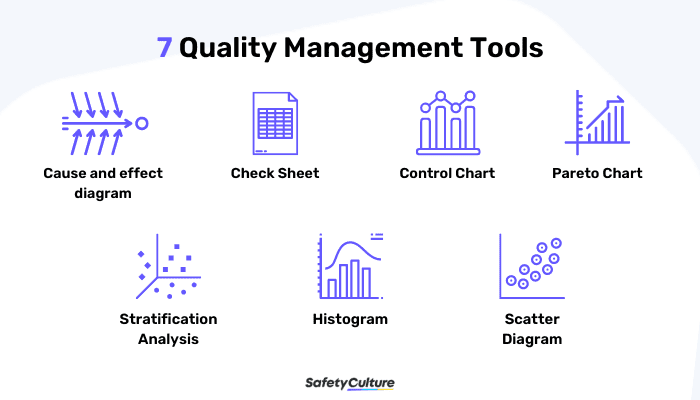What is Quality Management?
Quality management provides an agile framework to implement effective quality and productivity initiatives in every aspect of business operations. It focuses on improving the standards of organizational deliverables to meet customer needs and expectations such as performance, availability, reliability, and value for their money. Quality management guides the organization in maintaining the production of high-quality products and aims to eliminate substandard or waste products to consistently achieve customer satisfaction and promote an overall good business.
Being unable to meet customer expectations can lead to customer attrition, profit loss, and damaged business reputation. Quality management oversees all the activities and creates an efficient process to allow the teams to focus on high-impact activities to ensure continuous improvement on products or services and deliver with high quality.
What are Quality Management Tools and How do They Help with Process Improvement?
To provide customers with quality products and services, the management team utilizes quality management tools that can empower them to efficiently manage and perform audits to evaluate activities based on observation and analysis. It was originally developed by Kaoru Ishikawa, a Japanese professor of engineering at Tokyo University, to show simple graphical and statistical techniques to solve quality-related issues. There are seven basic quality management tools identified as follows:

These tools are used to identify possible causes of a problem based on observation and collected data including frequency, area, defects, and similar issues.
1. Cause and Effect Diagram
The cause and effect diagram, also known as the fishbone diagram, helps identify possible causes of an issue using a template with a resemblance to a fishbone. Quality management teams can identify a quality-related problem on the right-hand side of the diagram, with individual root causes and sub-causes branching off to its left. Mostly, categories such as methods, equipment, people, environment, and materials are used to identify the possible cause of the problem.
2. Check Sheet
A check sheet is a structured presentation of gathered data that are collected repeatedly by the same person from the production process. It helps identify defects based on type, location, or cause. It records preliminary data distribution and its frequency when measuring out processes indicating the number of times a particular value has occurred. It allows quality management teams to eliminate defects or errors within the processes, products, or services.
3. Control Chart
A control chart is also known as the Shewhart chart and is used to study the changes in the process over time. It shows whether the process variation is in control or is affected by different causes of variation, which is based on a comparison of historical control limits and current data. A control chart makes it easy for quality managers to identify factors that may lead to variations or defects considering whether a process is stable or predictable.
4. Pareto Chart
A Pareto chart is used to identify the most significant issue in the production processes that needs immediate rectification. It uses a combination of line and bar graphs to present the frequency of issues in the production process. It highlights the relative importance of a variety of parameters to analyze and determine the most impactful factor on a specific process or system. Quality managers can sort the number of defects from the largest to the smallest occurrences in order to identify which to prioritize in terms of improvement efforts.
5. Stratification Analysis
The stratification analysis helps quality managers divide different factors such as objects, data, and people into distinct groups to determine the revealing patterns that are not visible when those factors are lumped together. It is used when data comes from different sources and analysis may require sorting out from these sources. It can be presented in combination with other data analysis tools to identify the circumstances that could affect the quality of delivery.
6. Histogram
A histogram is utilized to show frequency distribution using numerical data. It is somehow similar to a bar graph as it shows patterns that fall within common process conditions. It helps quality management teams analyze the output from the processes of suppliers and check whether a process has changed from one period to another. It can be presented in different shapes as follows:
- Normal distribution
- Bimodal or double-peaked
- Skewed distribution
- Multimodal distribution or plateau
- Edge peak distribution
- Heat-cut distribution or truncated
- Comb distribution
- Dog food distribution
7. Scatter Diagram
A scatter diagram is the most useful tool in describing the cause and effect relationship between two variables. It uses the X and Y axis to look for relationships between quality defects and possible causes including activity, personnel, environment, and other variables. It helps determine whether two effects that appear to be related occur with the same source.
How Quality Managers Go Through Their Day
Quality managers are responsible for maintaining the high value of products or services and ensuring they consistently achieve customer satisfaction. It is vital to spot quality or product-related issues and defects early on before they reach end-production to avoid business damage. To efficiently perform their duties, they use quality management tools to identify issues and apply immediate corrective actions. Some of their tasks include the following:
Task #1: Data gathering
Data gathering is a crucial part to identify the cause and effect of an issue or defect. It is the starting point in creating hypotheses to identify the root cause of a problem. Collected data should be accurate and reliable to formulate appropriate insights and analysis.
Task #2: Identify the problem
The different quality management tools used to identify the problem depend on the needs of the company. It is vital to identify the cause of the problem in order to ensure the quality of products or services.
Task #3: Perform quality checks
Traditionally, the pen and paper method was used to perform quality checks. This method has allowed quality management teams to complete their task, but it can be difficult to track over time as critical data can get lost in the process. With SafetyCulture (formerly iAuditor), a web and mobile quality inspection app, quality managers can achieve the following.
- Get real-time data – All quality checks are saved securely in a cloud that can be accessed anytime, anywhere even when you are offline. It helps to easily check areas that need improvement and monitor results over time.
- Turn issues into actions – assign corrective actions to appropriate members of your team, including the description of the task, priority level, and due date.
- Provide photo evidence – Capture photos of defects and other issues in-app. Have an option to annotate and attach notes to further discuss the issue.
- Send quality assessment report immediately – Right after the inspection, you can send the completed audit to any member of the organization, you have an option to send reports on the mobile app to specific people via email.
- Create customizable templates – Start using our ready-to-use templates or check out our Public Library of free checklist templates. You also have an option to convert your existing PDF, Word Document, Excel, or PowerPoint files into SafetyCulture checklist for free up to 3 files.
Create Your Own Quality Management Checklist
Eliminate manual tasks and streamline your operations.
Get started for FREEAre There Other Quality Management Tools and Techniques?
Yes. As technology progresses, there are other tools and philosophies quality managers can utilize to ensure customer satisfaction. It has been developed to focus on quality control to eliminate waste. To get you started we have prepared ready-to-use templates that are highly customizable according to your business needs.




